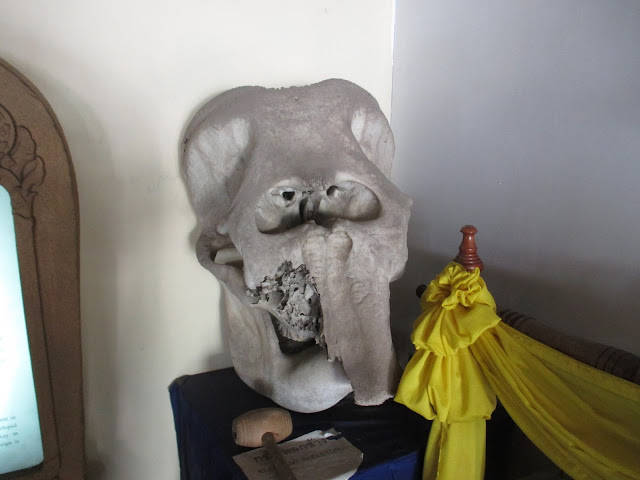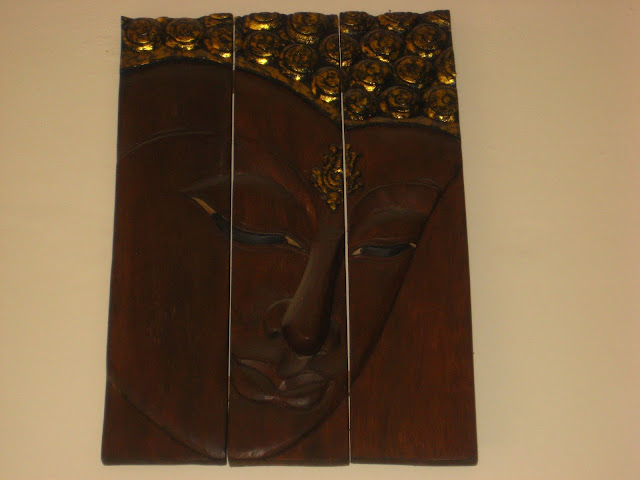February 16
We decided to
venture out of the old city. Joanna had a tip from the lady at the Coffee Bar
that the Warorot Road day market is the place to shop for bargains.
We had breakfast
in the garden at the U.N. Joanna’s stomach is still giving her a bit of
discomfort, so she had toast. Definitely nothing deep fried. I took advantage
of the Irish cultural influence and had baked beans and grilled tomato, along
with an egg and toast made from the U.N.’s bakery.
We strolled down
the soi toward the moat, and of course, passed yet another stunning temple. I
think the name is Wat Dok Eung. Across the street was an empty lot and an old
teak house that may be under restoration.
I learned a
little about teak houses when we stopped at the Lanna Architecture Center on Rachadamnone
Road the other day. The center is an old (maybe 19th century) teak house built
on a masonry foundation, so the bottom story is white and the upper is dark
brown.
The last private
owner was a wealthy merchant family who donated it to Chiang Mai University.
I gather that the
king of Chiang Mai lived there at one time. There is a photo on the wall that I
believe shows one of the later kings wearing no shirt and Yul Brynner pants,
sitting cross-legged on a chair with a sword across his lap. There’s a guy
kneeling next to him with an even bigger sword.
According to one
of the signs in English, there was a separate king of Chiang Mai until sometime
in the 1930s, when the government in Bangkok relieved the royal family here of
its civil duties.
They’re
apparently still around and keep the family names, but just have no official
function anymore.
The house is airy
and full of light. There is one bedroom made up in an early 20th century style.
The bed has a canopy with mosquito netting, and so reminded me of the bed in
Gregory’s villa on Bali.
We sat on the
balcony under an awning in the heat of the day, and the breeze evaporated the
sweat off my arm.
The teak house in
the otherwise empty lot on Moon Muang Soi 5, probably has some history too, but
there is nothing we could see to explain it.
Given our attempt
last week to cross the street by the moat, we took a tuk-tuk to the market. I
just don’t like being bullied by assholes on wheels.
We hailed one car
driven by a lady. Next to her sat another holding a baby doll. Until they
pulled over, we thought it was a real child. Why she was sitting next to the
driver with her feet hanging out of the car, we never did find out.
Not knowing how
to pronounce “Warorot,” we showed the driver our map and pointed to the place.
OK, that worked. How much? 80 baht. That’s less than $2.50. You can’t close the
door of a New York taxi for that.
The ride took
only a few minutes before we pulled up at the curb next to a sidewalk crowded
with vendor stalls. This is a collision of sensations I’ve never seen outside
of Asia.
The locals go
here to buy just about anything.
They go there for
their groceries–fruits and vegetables, live eels and frogs, toasted bamboo
worms, and so forth. Also for clothes, knick-knacks, gold jewelry–lots of gold
jewelry so yellow and bright that it looks fake.
Joanna passes.
People come up and speak to her in Thai. But I’m a Farang. I wasn’t the only
one there, by far, but the mix of local to foreign had shifted significantly from
inside the old city, which is a tourist haven. I suddenly felt exotic.
Joanna was
looking for silk scarves to give to her sisters and to the lady next door who
is collecting the mail. Apparently Thais don’t go to this market to get silk
scarves. We saw some on our way out of the market area, but they were
overpriced, maybe close to what we’d pay back home.
We wandered
through clothing stalls and food markets, and came to the River Ping, the
principal river of Chiang Mai City. It was closer than I remembered from the
map. At first, we thought we had walked back to the moat, but this is wider,
longer, and it bends.
We were standing
on a pedestrian overpass, because the roads are so crowded with frenetic
traffic that there is little likelihood of crossing at street level. The river
carried debris, mostly plastic, on the water, the inevitable sign of heavy
population, but otherwise looked almost rural: Green banks, with small boat
landings and individual houses with yards. There was a man getting ready to set
out in a long, narrow fishing boat.
Behind us, every
inch of space was packed with structures, people, and machinery.
We walked around
soaking up the sights, sounds, and smells. And there were plenty of them all.
There were
colorful umbrellas, Thai flags, live fish churning the water in a pail, a
bucketful of turtles, dazzling arrays of colorful fruit and vegetables, both
fresh and dried.
I heard all kinds
of languages, mostly Thai, I’d expect, but there’s no way to be sure. Tuk-tuks
and motor bikes were a constant background soundtrack. Once in a while somebody
would have music on a radio. People were haggling. Others were singing out
their prices. You learn something every day. This day, I learned “30 baht” is a
song lyric.
The smells are
the critical thing. You can see moving pictures or stills of a place, but it’s
not real till you’ve smelled it. Think engine exhaust, charcoal, curry, fresh
fruit, and pungent dried fish. Sometimes in sequence, sometimes all at once.
You’ll get an idea of how much fun this was.
We got lost
coming back from the river and walked down a wholesale street. We could tell.
We had the whole street almost to ourselves.
We came out of
there, and I knew I had lost my bearings. We walked to an intersection, but it
wasn’t the one I had hoped it would be. There was an arch there, covered in red
lanterns and inscribed with golden Han characters.
We walked a
little way, and Joanna saw a temple with Chinese writing on it. There was a
7-Eleven between us and it, so I was game to go. We ducked into the store and
bought a bottle of water. I also got an ice cream bar because I needed the
sugar. We both needed the air conditioning, and although I’m reluctant to admit
it, I needed water as much as Joanna did.
The temple
disappointed Joanna. She was upset by its condition. She said that the
Chinatowns in Bangkok and Chiang Mai lack civic pride. This was the only
Chinese temple she has seen in Chiang Mai and they treat it like a dump, she
said.
We walked back
from the temple and crossed the street. Damn, but that was the very spot where
the tuk-tuk had dropped us off. We walked half a block, got another ride, and
headed back for a nap.
At dinnertime, we
decided to go to the U.N. But first we took a short walk, with Joanna leading.
She wanted to test her sense of direction and her understanding of the
neighborhood.
Feeling
adventurous, she led me out the soi to Moon Muang, turned right and took me to
the Tha Pae Gate. She led me past our Soi 1, and remarked how we could get to
the bar that way. She led me to the next light, and turned right to the light
at the end of that block. Across the street and right again to the U.N. Irish
Pub.
I wanted a
hamburger, mainly to try the bakery’s bread. The roll was terrific, but the
burger seemed to be factory made. So were the onion rings. It wasn’t bad.
Indeed, it was OK. But from my experience here, OK food is not going to cut it.
Next time we go
there, I may try the quiche or the Irish stew. We’re going to be here for
another week, so maybe I’ll get to eat both.
Joanna had a soup
with chicken, vegetables, and coconut milk, which one of the waiters
recommended as soothing. She ate the chicken, some of the broth, and much of
her rice, but she is still not feeling right. She went back to the hotel, while
I went to 7-Eleven for a few supplies.
Speaking of
supplies, my beer stock is running low, gang.
So I’m going to
have do one of the things Santa Claus does:
either harness my
reindeer and head over to Clement Moore’s house;
or say Happy
Christmas to all and to all a good
night.
Harry
Feb. 16
I think the doll you saw may have
been one of the "Luk Thep" dolls that have been covered with some
curiosity in Western media over the past month or so:
Kate




















